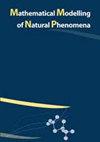细胞拥挤和饥饿如何影响EMT6/Ro肿瘤的无血管肿瘤生长?
IF 2.1
4区 数学
Q2 MATHEMATICAL & COMPUTATIONAL BIOLOGY
引用次数: 0
摘要
在这里,我们重新检查了EMT6/Ro肿瘤体积和活缘厚度的体外实验数据。这表明,生长速度在时间上是恒定的,并且在高浓度时不受营养物质浓度的影响,但在高浓度条件下,活菌边缘厚度增加。然后,我们提出了一个简单的机械反应-扩散方程,其中包括拥挤和饥饿效应,并表明该模型定性地捕获了实验观察结果。此外,该模型预测癌细胞浓度以波脉冲(孤子)为特征,并通过对应于大波速度的零阶微扰分析来探索脉冲形状。结果表明,该零阶项在实验条件下占主导地位,进一步表明非线性反应决定了脉冲特征形状。最后,在低营养物质浓度时,我们发现锋面是拉前的,即生长速度由波锋面边缘的细胞增殖决定,与早期的建模方法一致。本文章由计算机程序翻译,如有差异,请以英文原文为准。
How do cell crowding and starvation affect avascular tumor growth of the EMT6/Ro tumor?
Here we re-examine experimental in vitro data for the EMT6/Ro tumor volume and viable rim thickness. This shows that the growth speed is constant in time, and independent of nutrient concentration at large concentrations, but that the viable rim thickness increases in this high concentration regime. We then present a simple mechanistic reaction-diffusion equation that includes crowding and starvation effects, and show that the model qualitatively captures the experimental observations. Moreover, the model predicts that the cancer cell concentration is characterised by a wave pulse (soliton), and the pulse shape is explored through zero’th order perturbation analysis corresponding to large wave speeds. It is shown that this zero’th order term is dominant for the experimental condition, further indicating that the non-linear reaction governs the pulse characteristic shape. Finally, at low nutrient concentrations we find that the front is a pulled-front, that is, the growth speed is determined by the cell multiplication at the wave front edge in accordance with earlier modelling approaches.
求助全文
通过发布文献求助,成功后即可免费获取论文全文。
去求助
来源期刊

Mathematical Modelling of Natural Phenomena
MATHEMATICAL & COMPUTATIONAL BIOLOGY-MATHEMATICS, INTERDISCIPLINARY APPLICATIONS
CiteScore
5.20
自引率
0.00%
发文量
46
审稿时长
6-12 weeks
期刊介绍:
The Mathematical Modelling of Natural Phenomena (MMNP) is an international research journal, which publishes top-level original and review papers, short communications and proceedings on mathematical modelling in biology, medicine, chemistry, physics, and other areas. The scope of the journal is devoted to mathematical modelling with sufficiently advanced model, and the works studying mainly the existence and stability of stationary points of ODE systems are not considered. The scope of the journal also includes applied mathematics and mathematical analysis in the context of its applications to the real world problems. The journal is essentially functioning on the basis of topical issues representing active areas of research. Each topical issue has its own editorial board. The authors are invited to submit papers to the announced issues or to suggest new issues.
Journal publishes research articles and reviews within the whole field of mathematical modelling, and it will continue to provide information on the latest trends and developments in this ever-expanding subject.
 求助内容:
求助内容: 应助结果提醒方式:
应助结果提醒方式:


